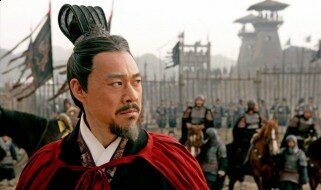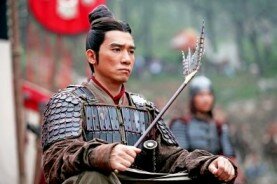Fans of Chinese cinema will understand that Western influences are often woven into Eastern features and that history is integral to their storytelling. With so much culture behind them, it’s easy to get lost in the possibilities for movie ideas – so it makes sense that Asia’s most famous novel now gets a look in for international audiences. Romance of Three Kingdoms, Luo Guanzhong’s 14th century novel, has remained a huge influence in China throughout history both as a historical and romantic tale but the film adaptation presents us with what’s expected out of China – action, and lots of it.
Red Cliff is definitely presented as one for the boys – those up for plenty of battles and blood will get the most from it. Set in the Han Dynasty of 208AD, the Battle of Red Cliff sees real-life rebels Liu Bei (Yong You) and Sun Quan (Chen Chang) band together to fight the tyranny of Prime Minister Cao Cao (Fengyi Zhang), who intends on staging a coup to overtake rule of China’s Southlands. The film hits a higher gear as we get more glimpses on who really drives the war: strategist Zhuge Liang/Kongming (House of Flying Daggers’ Takeshi Kaneshiro) and Viceroy Zhou Yu (Lust, Caution’s Tony Leung Chiu-Wai); its these characters that give Red Cliff strength in its plot.
 |
Director John Woo returns to Chinese cinema for the first time since 1992, having made history in Hollywood as their first Asian director (with 1993’s Hard Target). It’s clear he remembers how it’s done, using his signature doves to represent purity and peace along with heavy emphasis of faraway looks and stylised battles to bombard you with visual splendour. Beautiful blood is shed like a painting on a canvas in well-choreographed sequences; the landscape is a mix of barren Western hillsides and vast seas as different weather patterns influence how and when the opponents choose to battle. Stylistically, Red Cliff falls within the line of most Chinese cinema, focusing on the effortless skill of men in battle. And, like some Chinese cinema, it slightly overuses it. Woo, also a co-screenwriter, relies too heavily on the battle scenes between character interactions and draws the middle out for longer than necessary (even within our ‘cut’ version – the Chinese epic is split in two parts).
 |
It’s not the easiest film to comprehend with its multiple characters, but American introductory narration and labelling of the characters is still oddly unsettling as the film begins. The film’s more comical moments from outside characters also seem out of place within the context – but aren’t so farfetched as to be totally irrelevant. However, those wanting a challenge will appreciate Woo’s work in bringing Red Cliff to the screen –the film does have an epic feel about it as you genuinely want to see how it all unfolds. The cultural intricacies are so intriguing – although obviously understood better by a local audience, the use of music and tea as spiritual communicators set the film apart from its Western counterparts. Cannes Best Actor winner Leung Chiu-Wai and Kaneshiro are particularly impressive as the strategic masterminds, while the female (romantic) influence is strong through Xiao Qiao (Taiwanese supermodel Chi-ling Lin in her first feature). Like most films in our common era, historical events provide openings to present a metaphor of some sort, and it’s easily plausible that Woo could be making a subtle statement about China’s current political stance. The story of Red Cliff has stood through the test of time in its literary form, so who’s to say that the film adaptation won’t help it along and open it up to a much wider audience?
Verdict
Red Cliff is pure visual indulgence, plot all but forgotten when the battle is nigh. Good lead performances give this story a worthy life amid its few faults.
Red Cliff opens across Australia on July 23, 2009.
 Follow the author Katina Vangopoulos on Twitter.
Follow the author Katina Vangopoulos on Twitter.




 Interview: Stephan Elliott, director of A FEW BEST MEN
Interview: Stephan Elliott, director of A FEW BEST MEN

![The Class [Entre les murs] (Review) The Class [Entre les murs] (Review)](/wp-content/uploads/story11-150x150.jpg)









